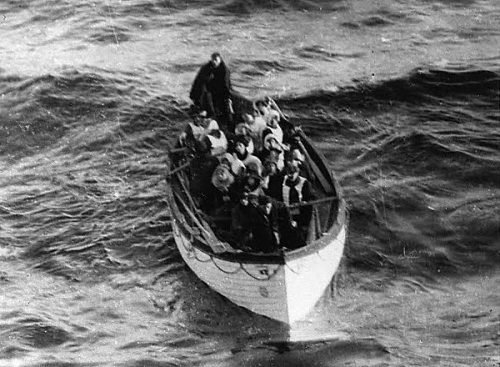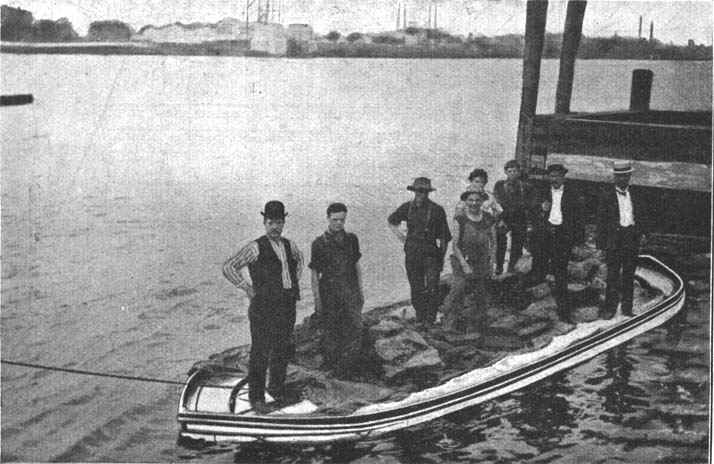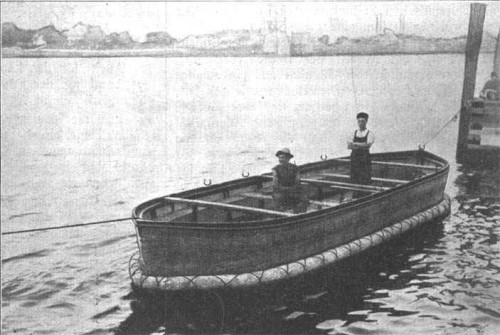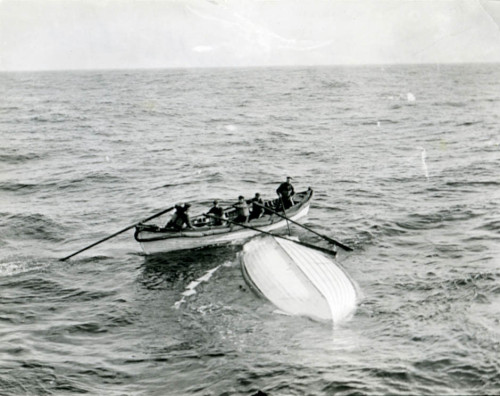
Blog: The Last Minutes on the Titanic
The passengers on the RMS Titanic were multimillionaires, seamstresses, bankers, shop owners; they ranged in age from 74 years to 2 months; some were married, some were single, some were engaged; and each person had a story worth telling. Five of the passengers on board lived in Washington, DC, including the last survivor to leave the ship, Colonel Archibald Gracie IV.
Archibald Gracie was a wealthy gentleman and amateur historian in his early 50s when he booked a first class ticket on the Titanic to return home after a brief trip to Europe. He was a very social and energetic man who loved telling stories about the Civil War. He quickly made friends with others in his social class aboard the ship, including Isidor and Ida Straus, the owners of Macy’s department store (played by John Leslie Wolfe and Florence Lacey in our production of Titanic).
On the fateful evening of Sunday, April 14, 1912, Gracie spent time with his fellow first class passengers eating dinner and listening to the ship’s band, and then he retired early to rest before an early-morning squash game.
Gracie was jolted awake three hours later at 11:45 p.m., and he went out into the corridor to see why the ship had stop moving. There was no commotion or panic in the hallway, and in fact Gracie wandered the ship for several minutes before finding a group of other passengers who told him that the Titanic had struck an iceberg and the ship was taking on water. The first class steward led him up to the Boat Deck, and at this point none of the passengers had any inkling of the disaster that had already begun.

Passengers aboard Lifeboat 6 row toward the Carpathia.
Gracie and the other first class passengers were hopeful of rescue - Gracie pointed out a light from the Californian, another large passenger ship, just a few miles away. Little did he know, the Californian was surrounded by ice and its captain Stanley Lord chose not to risk his ship to move toward the lights his crew saw in the distance. (The story of the subsequent investigations into Lord’s inaction is fascinating but too long to cover in this post; suffice to say, his reputation never fully recovered after the Titanic disaster.)
The rescue orders on board the ship were “women and children first,” and initially Gracie and the other male passengers were kept away from the lifeboats. Soon, however, the deck was tilting at a noticeably steep angle, and the crew allowed Gracie and other men to assist them in loading the remaining lifeboats. With the band on board the ship playing in the background, he had to separate wives from husbands and fathers from their children as the ship dipped lower into the water. He witnessed Ida Straus refuse to leave her husband to save herself on a lifeboat; after 40 years of marriage, she chose to die with her husband Isidor on the ship rather than live without him.
After midnight, a crewmember fired five distress rockets into the night sky. Gracie later wrote that “these signals of distress indicated to every one of us that the ship’s fate was sealed, and that she might sink before the lifeboats could be lowered.”

A collapsible lifeboat with the sides down.
By 2:05 a.m., all of the regular lifeboats had left the ship only partially filled and Gracie and other remaining passengers and crew hurriedly tried to fill and lower the Engelhardt collapsible lifeboats, which had wooden bottoms and collapsible canvas sides. All but one were hastily lowered before the bridge dipped underwater ten minutes later. Gracie and his friend Clinch Smith moved toward the stern of the boat, which was still mostly afloat. At this point Gracie and Smith ran into a large group of third class passengers, including women and children, who were just coming up onto the deck; their safety was an afterthought for the crew, and they were apparently forgotten in the calls for “women and children first.” The steerage quarters were on the opposite side of the ship from the lifeboats, and many of them were trapped by the barrier that separated the third class from the first and second.
Gracie, Smith, and the forgotten steerage passengers were trying to find a path to the stern of the boat when a “great wave” rushed over the ship. Gracie was able to use the wave’s momentum to jump onto the roof of the officers’ quarters nearby, but when he looked back, Smith and the other passengers nearby had been washed overboard. Many of the third class passengers on the ship never had a real chance of survival. The wave also swept the last collapsible rescue boat off the ship, and the boat hit the water bottom up but still afloat.
There were no more lifeboats on board the Titanic and the ship was sinking quickly. Gracie was dragged down into the ice-cold water, still holding on to the roof of the officers’ quarters. He may have been the last survivor off the ship. He swam as fast as he could up and away from the ship, and by the time he broke the surface, the Titanic had disappeared underwater completely. The only signs that the magnificent Ship of Dreams had been there a few minutes before were the floating debris that scattered the ocean and the screams of men and women dying in the clear, bright night.

A collapsible lifeboat with the sides up.
Gracie found a floating crate on which he attempted to balance to stay above water, but after falling into the near-freezing ocean twice he knew he had to find a more stable piece of debris to cling to safety. Looking out into the night, he saw the overturned Collapsible B lifeboat in the distance and knew it was his best chance for rescue. Gracie swam out to the collapsible and pulled himself aboard; he estimates that about twenty men perched on the upturned bottom of the boat when he got there, include Marconi telegraph operator Harold Bride (played by Nick Lehan in our production) and Second Officer Charles Lightoller (played by Matt Conner in our production).
Men and women swimming from the ship surrounded the boat in the water, and Collapsible B was soon holding more men than it could support. It slowly started to sink lower into the water as more and more swimmers tried to climb on. Two crewmembers used pieces of debris as makeshift oars to row the collapsible away from the desperate men swimming toward them; Gracie and the other men on the boat stopped helping others on board for fear that one more person would cause the collapsible to sink.

Collapsible B, the overturned lifeboat on which Gracie and 30 other men stood for hours awaiting rescue.
As Gracie silently prayed for rescue, one of the crewmembers on the collapsible asked everyone on board their religious beliefs. All belonged to Christian sects, and the crewmember led them in a group recitation of the Lord’s Prayer. As their voices rose above the sounds of desperation in the cold night air, Gracie felt united with his fellow men as sons of God; he was the only first class passenger on the collapsible, but he later wrote that the men were stripped of their class differences in the face of this terrible tragedy.
Over the next two hours, Gracie, Harold Bride, Officer Lightoller, and the other crewmen aboard the boat waited in the cold and dark for rescue. Several men on Collapsible B died from exposure or fell into the water from exhaustion and drowned, and most of the men sustained complications from frostbite, including Gracie. As the crewmen discussed the fates of other passengers and crewmembers, Gracie learned that the Titanic’s Captain E.J. Smith drowned when Collapsible B was washed off the ship.
Just before dawn, the lights of the Carpathia appeared 4-5 miles behind them, stopped by another iceberg. With the upturned collapsible still slowly sinking under the weight of 30 men, they had no hope of rowing that far to safety. Fortunately the dawn light revealed a group of only partially filled lifeboats from the Titanic. Officer Lightoller got their attention by blowing his whistle and yelling for them to come take the men off Collapsible B, who were now standing on the upturned boat in knee-deep water. The Collapsible B survivors carefully boarded the two intact lifeboats, and by 9:00 a.m. Archibald Gracie was safely aboard the Carpathia with a hot drink and warm blankets.

Survivors huddle on the deck of the Carpathia.
Gracie never recovered his health after the sinking, and he died 8 months later of complications from diabetes and hypothermia. He dedicated his short life after the Titanic to writing his detailed and thoroughly researched account of that night, and it remains in print today. The Truth about the Titanic (later renamed Titanic: A Survivor’s Story) should be read with a critical eye, like any memoir; he almost exclusively writes about first class passengers and probably exaggerated the heroics and noble actions of the first class men and crew on the ship. It is, however, the most thorough eyewitness account of the Titanic disaster and provides a large amount of detail about the final moments on board the ship that is not available in other sources. Gracie spent the last months of his life trying to determine what happened to the first class passengers and officers who died in the sinking to provide consolation to their families. Many fellow survivors and victims’ families attended his funeral in New York. Gracie’s last words were, “We must get them into the boats. We must get them all into the boats.”
Get your tickets to Titanic
Don’t miss Signature’s epic production of Titanic, now running through January 29!